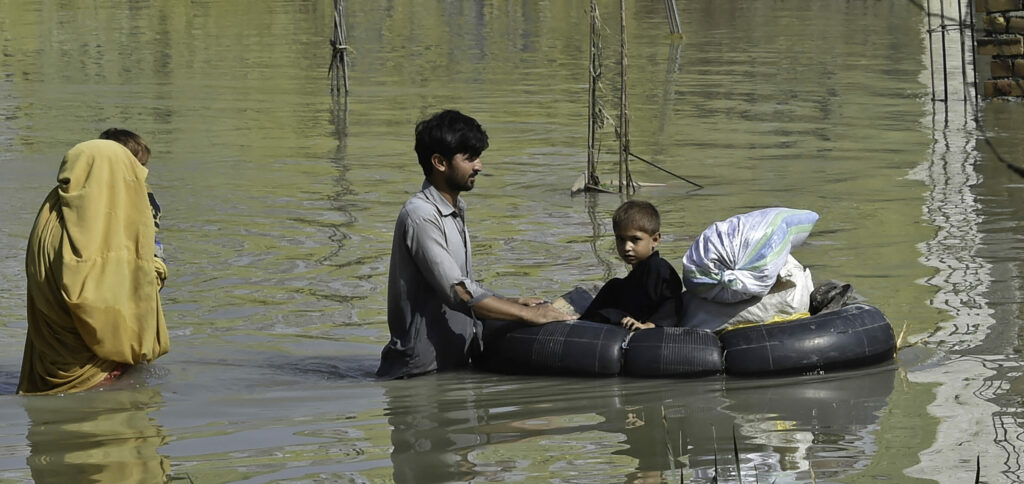💧 Pakistan underwater
More than 33 million people – one Pakistani in every seven – have been affected by this year's rains in the country and almost a million homes have been destroyed or badly damaged, according to government data.
ADVERTISING
Southern Pakistan – affected by major flooding – is bracing for more flooding as riverbeds rise following monsoon rains.
“Some villages were annihilated and millions of homes destroyed. There is enormous destruction,” declared Prime Minister Shehbaz Sharif.
The country's National Disaster Management Authority said on Sunday (28) that the death toll from the monsoon rains had reached 1.033, with 119 deaths in the previous 24 hours.
ADVERTISING
Sherry Rehman, Senator and Minister of Climate Change of Pakistan, said the country is going through a “serious climate catastrophe, one of the most difficult of the decade”system. (The Guardian*)
The Pakistani government attributes the extreme phenomena to climate change and claims that the country suffers the consequences of irresponsible environmental practices in other regions of the world.
Pakistan is particularly vulnerable to climate change. The country is in eighth position among the countries most threatened by extreme weather phenomena, according to a study by NGO Germanwatch. (*)
ADVERTISING
🌱 Who was the “Indian of the Hole”, found dead in Rondônia?
The indigenous person known as “Indian Tanaru” or “Indian of the Hole” was found dead by the National Indian Foundation (Funai) last Tuesday (23). The information was confirmed by the agency last Saturday (27)system. (G1)
The indigenous man in the hole: do you know who he was?
He became known as “Indio do Buraco” (SIC) and lived alone for almost 30 years in Rondônia, after the last members of his people were killed by farmers in 1995. He was first seen a year later, in 1996, by the Guaporé Ethnoenvironmental Protection Front (FPE Guaporé), based in Alta Floresta do Oeste (RO).
The indigenous people of the Tanaru Indigenous Land (TI) have been victims of historic events in the Amazon since 1980 – where rampant colonization, the installation of farms and illegal logging in Rondônia provoked successive attacks on isolated indigenous peoples who lived in these regions, resulting in expulsions from their lands and deaths.
ADVERTISING
He became known as the “Hole Indian”, because he dug inside the hut he lived in, made of straw. Scholars believe that the hole had a mystical value for the indigenous peoplesystem. (Real Amazon)
Curto curation:
- Is the indigenous genocide not over yet? (Politicize!)
- Brazil is cited at the UN for risk of genocide of indigenous people (DW Brazil)
- Last survivor of tribe, Indian has lived alone for 22 years in the forest of Rondônia (G1)
- Find out how Funai found, 26 years ago, the recently deceased “Indian from the hole” (Galileo Magazine)
☀️ 'Dangerously hot': predictions for 2100
As heat waves – which have raised temperatures to record levels across much of the world in recent months – will become increasingly common by the end of the decade, according to study published in the journal Communications Earth & Environment. (*)
Experts say how hot they will be depends “hugely” on our ability to reduce carbon emissions In the next years.
ADVERTISING
“The difference between being very proactive and limiting carbon emissions to maintain the parameters set by the Paris agreement, and not doing so, is extremely important for billions of people, particularly across the global south,” said Lucas Vargas Zeppetello, a of the study authors, to the newspaper The Guardian. (*)
The team of scientists used historical climate data and combined it with future projections of population growth, economic growth and carbon emissions to develop a probability-based formula to estimate what global temperatures would be like in the future.
“Without more aggressive emissions reductions than considered possible by our statistical projection, it is likely that by 2100, many people living in tropical regions will be exposed to dangerously high Heat Index values during most days of each typical year, and that the types of heat waves that were rarities in mid-latitudes will become annual occurrences”, says an excerpt from the research.
🐬 Dolphins are victims of the War in Ukraine
Scientists have found a large number of dolphins dead since the start of the conflict in Ukraine.
“We started communicating with our Turkish, Bulgarian and Romanian colleagues, and they all came to the same conclusions: there are a large number of dead dolphins since the start of the war,” said Ukrainian researcher Ivan Russev, who has been tracking the effects of the war on local fauna and flora since the beginning of the Russian invasion.
The Turkish Foundation for Marine Research (TUDAV) already expressed concerns in March about an “unusual increase” in deaths of dolphins found off Turkey’s Black Sea coast.
Russev estimates that “5.000 dolphins died according to the data collected”, that is, almost 2% of the total population of the animal in the Black Sea.
“Last year, on our 44 km of coastline, we found a total of 3 dolphins. This year, just in the 5 km where we have the right to operate, we have already found 35”, he explains to AFP.
However, it is impossible to know exactly how many died elsewhere on the reservation. Fearing a Russian landing, the Ukrainian army prohibits park officials from accessing most of the area.
For the scientist, there is no doubt. The culprits of this current catastrophe are the powerful sonars used by Russian warships and submarines that circulate in the Black Sea, which disrupt “the dolphins’ acoustic system”. Weakened, the animals become ill and die from infections.
The 3 species of dolphins found in this almost closed sea – estimated at two million in the mid-XNUMXth century – are victims of fishing and pollution decades ago.
The last record in 2020 was 250.000 animals, says Russev.
“War is a terrible thing. It has an impact on the entire ecosystem, on species that will have difficulty recovering and restoring the balance of nature”, he laments.
And it wasn't the first time that dolphins were characters in this war, read more:
- Russia is using dolphins to protect Black Sea naval base, satellite photos suggest (The Washington Post*)
- Dolphins are used as 'spies' by the Russian Army in the war in Ukraine (G1)
- Sonar and explosive: how dolphins trained in Russia become a weapon of war (UOL)
O Curto Verde is a daily summary of what you need to know about the environment, sustainability and other topics linked to our survival and that of the planet.
(With AFP)
(🚥): may require registration and/or signature
(🇬🇧): content in English
(*): content in other languages is translated by Google Tradutor



